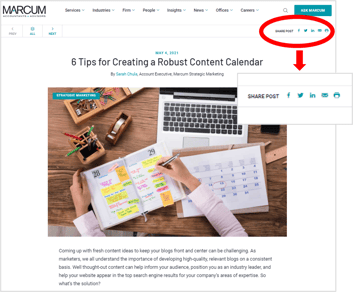
Content marketing is one of the most effective marketing strategies for securing qualified leads. But it ain’t easy. Simply writing a monthly blog and posting it to your website won’t meaningfully increase your company’s search rankings nor will it position you as an industry expert.
Why? Because there’s already a lot of content out there.
And by a lot, I’m talking like a crazy, insane amount. In fact, as you read this, millions of blogs have already been written and posted today alone. And if you think your business is special, unique and thus somehow exempt, try doing a simple Google search for an article topic idea. My guess is you’ll find dozens, if not hundreds, of results.
What this all means is that it is hard - and getting harder - to rank for your business’s specific keywords and reach your target audience.
And if all this doesn’t make it a daunting enough task, we are finding companies committing the same content marketing mistakes again and again – preventing them from achieving the results they want.
Before we get into the mistakes, let’s first quickly touch on the benefits of content marketing.
Your customers and prospective customers come to you because they are seeking expert advice. They have specific questions, challenges, and needs - the solutions to which you provide. If you want them to find you, perceive you as the industry expert/leader and buy from you, be sure to focus your article topics around their biggest needs.
Here’s a few of tools and strategies to help you develop the type of content your target audience wants:

Put together a list of the questions most frequently asked by your customers. Each one of them will make for a great blog article and is guaranteed to be a relevant topic of interest.
If you have given any well-attended webinars or seminars, the content from each slide or series of slides will make for great article content. If there’s enough, you can turn the articles into a series and eventually into an e-book.
Sign Up to Receive Our Latest Blogs, Newsletters and Event NoticesArticles with heavy blocks of text and zero images to break them up make for intimidating reads that often result in readers abandoning the article before finishing it. Some people just immediately opt for the back button at the mere sight of an all-text page.
The majority of people scan articles, looking for visual markers like charts, bulleted lists, infographics, videos and screenshots.
According to a recent study, 41.5% of marketers reported that their infographics saw more engagement than their other forms of content.
Why? Because images are much easier for readers to digest than large chunks of text, and they make the article look more interesting and inviting to read.

Source: Neil Patel & Poll Everywhere
Try converting an old article or your next blog idea into an infographic. Below is a great example that illustrates (literally) what I’m talking about:

Source: HubSpot
To reinforce the importance of using images to break up heavy blocks of text, let’s use a Google screenshot to explain what evergreen content is.

Your goal when writing evergreen content should be to create a piece of thought leadership that will hold its relevancy and drive traffic to your website for 3-5 years.
That doesn’t mean you should stop writing on essential current news and events. Providing updates and insights on latest trends, products, technologies and regulations that affect your customers and their businesses are important. The issue with timely news articles is that they only drive traffic to your website for a few days or weeks. Evergreen articles can drive traffic for years.
The chart below does a great job illustrating what evergreen website traffic looks like in comparison to time-critical content.

So, if your goal is to drive relevant traffic to your website and capture quality leads, evergreen content is the way to go.
Secure a Free SEO Report to Find Out the Most Important Keywords for Your BusinessCalls-to-action (CTAs) are promotional links used to grab the attention of potential leads in an effort to convert them into customers. They are a critical component of the success of every content marketing lead generation process.
Recently, we were speaking with a company in the professional services space that had been writing and posting more than four articles a month for the last six months. Their content development process followed all best practices, and traffic to their website had increased meaningfully. However, they were frustrated as to why they weren’t securing very many leads.
The answer turned out to be pretty simple: There were no CTAs pushing site visitors to a desired endpoint (e.g., a special offer or downloadable piece of content) where they could be converted.
HubSpot does a great job capturing leads from all of its blog posts:

And here’s a shameless example using our own Guide to Generating Inbound Leads.
CTAs can be used all over your website to help convert site visitors into qualified leads.
To me, the hardest part about content marketing is the writing. It’s a labor of love to be sure, but I find the emphasis falls more on the side of “labor,” and I know I am not alone. So now that you’ve put the time, effort and resources into creating a great piece of content, you want to make sure that you’re promoting it to your target audience.
Now, you might be thinking, “Isn’t posting it to my blog page enough?” Not by a long shot.
Zero promotion = Zero site traffic = Zero Conversions = Angry boss.
When it comes time for content promotion, consider the following:




We’ve had tremendous success over the years driving inbound traffic and securing leads through content marketing. There’s no question it works, and companies across all industries are incorporating content into their marketing strategies. In fact, 53% of corporate marketers have made article creation the focus of their inbound marketing efforts.
But remember, successful content marketing requires more than just randomly writing and posting articles. Be sure to avoid these five most common mistakes:
If you’re looking for help developing and/or implementing a strategic content marketing campaign that connects with your audience, boosts website traffic and secures more qualified leads, email Jonathan Ebenstein.

These Stories on Inbound Marketing
Have lingering questions after checking us out? We’re here to help! And don’t worry—we won’t go into sales-stalking mode. So please feel comfortable filling out the form below and take us up on our offer to help.
About Us
Our Work
Contact
Strategic 7 Marketing
6685 Beta Drive
Cleveland, OH 44143
440.772.0186